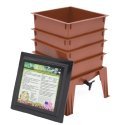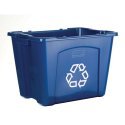The central idea with compostable bags is to offer an alternative replacement for our traditional petrochemically based plastic bags that take hundreds of years to breakdown in a landfill, creating serious issues with sustainable practices. Buy Biodegradable Bags here.
There are two main kinds of biodegradable bags A.K.A biobags, one is more environmentally friendly than the other, those with starch based polymers are greener and those petrochemically produced bags with an additive base hold up like the real deal but release CO2 upon breakdown.
Each kind has strong points, and each their specific weak points, but which solution is more sustainable for a given population really depends on the location of composting facilities in the area, and the specific needs of that given population.
Not everyone enjoys the starch based Polythene film products because certain precautions need to be taken in regard to how they are used.
They do not replace petroleum plastics in the sense that they are not as rugged or enduring, having a lifespan and shelf-span, much like food products do.
Starches like wheat, corn and potatoes are usually used, meaning that this product competes with those kinds of food products, possibly even threatening consumption both of the food and the plastic product as crop yields help determine prices and supply.
Agriculturally speaking, this is an alternative that will eventually stimulate the area to produce more starch-based crops and alternative methods of production will come about the more space is restricted and consumer demands grow, but eventually the conditions for a more self-sufficient economy will become ever clearer.
Starch-based Polythene is also known as biobased (hydrodegradable) and reaches the American Standards for Testing Materials as well as the European norms for compostability degrading in 60% under 180 days.
Polymers that usually use starch are Polycaprolactone (PCL), Polyvinyl alcohol (PVA) and Polylactic acid (PLA), all used to control the microbial breakdown, only allowing breakdown in the presence of microbes, heat, moisture and proper aeration, such as those conditions found in traditional compost piles.
Additive based plastic bags on the other hand are our traditional plastic bag films with a special chemical adjustment so as to make them breakdown more readily under certain conditions.
Instead of taking hundreds of years to breakdown, these plastic bags will take only six months to two years, accelerating their breakdown process considerably, clearing up landfills and other litter issues, such as those found in nation parks, forests, sewers, storm drains and other water ways.
So are these additive-based compostable bags a more sustainable alternative? Not really, they certainly dont need consumers to be aware of how to use them, and they work just like what consumers have now, but they release CO2 upon degradation and petroleum is a limited resource that depends greatly on foreign affairs of state, which contributes to instability.
In the first stages of decomposer, oxygen, light, heat and/or stress react on a molecular level, fragmenting the film in such a way that water can wet and surround its molecules, thus making it readily biodegradable, leaving only CO2, water and biomass once microorganisms get a hold of it.
These oxodegradable/photodegradable plastic bags may make things easier without causing much change in the consumers lifestyle today and cost a little less right now when compared to those that are starch based, but in the long run, this is not a sustainable alternative, thus they do not meet European standards for compostability.
Between the two main alternatives in compostable bags, starch based trash bags are less resistant than the traditional plastic bags with an additive base, and also require more consumer care while using them, but in the long run, starch based bags take less time to decompose (up to 180 days) while additive based bags may takea couple of years (up to 2 yrs) and have the downside of being made from petrochemicals as well as releasing CO2 into the atmosphere.
In the end, the compostable bags you choose need to be right to fit your needs, only you know how green you can be…
Good list of current “approved” bags at:
BPI World Approved Products





